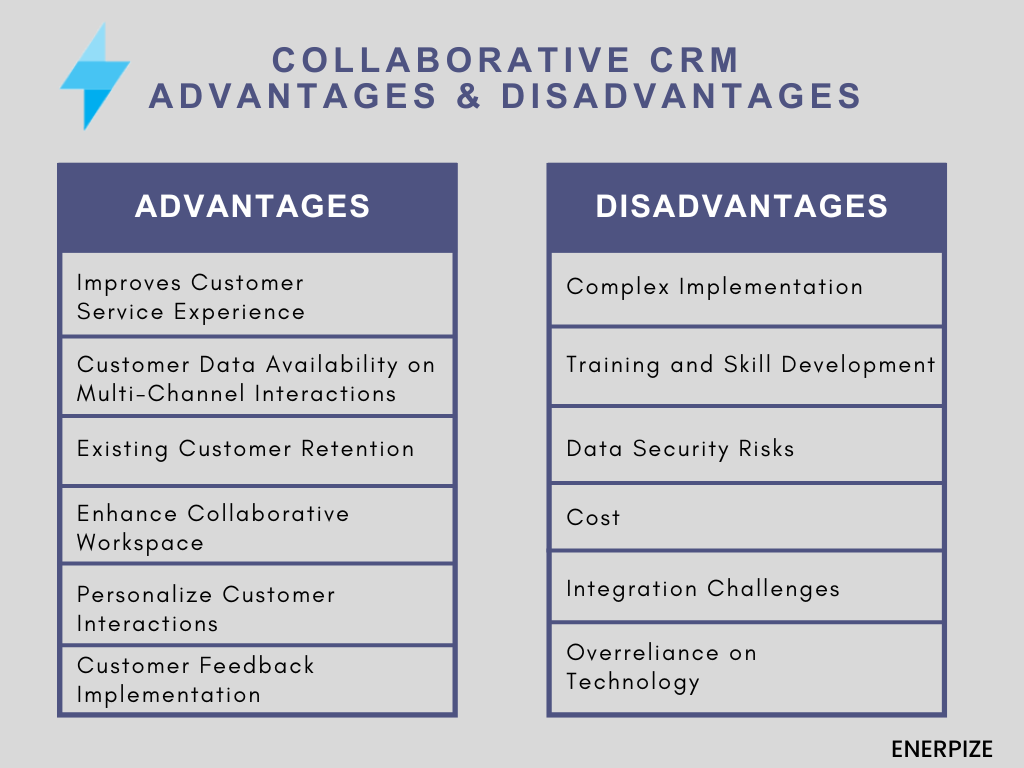Author : Haya Assem
Reviewed By : Enerpize Team
Main benefits of collaborative CRM: Definition, Types, and Features

The success of any business depends heavily on its customers and how satisfied they are with a particular product or service. As a result, customer relationship management (CRM) is often seen as a critical pillar for businesses seeking to prosper and achieve customer loyalty, satisfaction, and trust. CRM comes in several forms, each of which performs differently.
Collaborative CRM is one of these, and it is the most important since it is based on departmental collaboration, in which all corporate departments work together to serve customers and acquire their complete satisfaction.
This collaborative approach improves coordination and customer interactions. With access to shared data and insights, teams can provide a more consistent experience to customers, strengthening the bond between them and the company.
When teams work together harmoniously to respond to customer demands, resolve issues quickly, and respond swiftly to changing market dynamics, the company prepares itself for long-term success in a changing business landscape.
Key Takeaways
- Collaborative CRM integrates departments using software to enhance communication, break down walls, and adopt a customer-centric approach, aiming to improve overall customer relationships and satisfaction through shared information and interactions.
- Employs strategies and tools for enhanced interaction and collaboration across organizational divisions. It encompasses Interaction Management for personalized customer experiences and Channel Management for optimized multichannel interactions, emphasizing analytics and security.
- Key features include transparent teamwork, customer satisfaction, cost efficiency, effective communication, multi-channel interaction, customer feedback, online retention services, streamlined information, and better upsell opportunities.
- Improve interaction among business departments, providing benefits like enhanced customer service, data availability across channels, customer retention, improved workspace collaboration, personalized interactions, and effective customer feedback implementation.
- Collaborative CRM includes various types such as Collaborative Selling, which focuses on sales team coordination; Collaborative Marketing, which improves campaigns through shared databases; Collaborative Customer Service, and Collaborative Product Development.
- It has also some drawbacks including complex implementation, training needs, data security risks, significant costs, integration challenges, and potential overreliance on technology, impacting operations and security.
What is a collaborative CRM?
Collaborative Customer Relationship Management (CRM) is a business strategy and set of software tools meant to improve communication and collaboration across various departments within an organization, aiming to enhance customer relationships and satisfaction.
Different departments, such as sales, marketing, customer support, and occasionally even external partners or suppliers, exchange information and interact in a collaborative CRM system to better serve and understand the customers' requirements strategy strives to break down departmental walls, encouraging a more integrated and customer-centric approach to business.
Essential components of collaborative CRM
Collaborative CRM is a set of strategies and tools used to improve collaboration as well as interaction across an organization's many divisions. The following are the two essential components of collaborative CRM:
Interactions Management
Interaction Management offers comprehensive insights into customer demands and histories, allowing for personalized interactions and efficient workflows, among other features:
Customer communications are recorded and analyzed across several channels, resulting in a strengthened customer database.
Details of interactions are recorded and preserved for future use, creating a detailed customer history.
Use interaction data to tailor communications and offers, improving the entire customer experience and fostering stronger relationships.
Create systems for gathering customer feedback following the experiences, allowing for continual development based on user feedback.
Channel Management
Channel Management integrates many communication channels, optimizing customer interactions while providing an omnichannel strategy via analytics and security measures, and other aspects:
Determine the preferred channels for clients based on interaction data analysis.
Ensures a centralized customer database for up-to-date data.
Customize communication methods for each channel based on the type of interactions and user preferences on that platform.
Ensure that data is readily exchanged across channels, avoiding silos and enabling a single knowledge of customer behavior and preferences.
Implement strong security measures across all channels to secure customer data and ensure compliance with data protection regulations.
Different types of collaborative CRM
Based on the specific collaboration needs and focus areas within the customer relationship management process, collaborative CRM may be classified into multiple types such as the following:

Collaborative selling
Focuses on enhancing the selling process through sales team collaboration. Utilizes shared sales databases, collaborative forecasting, and tools for coordinating sales strategies and activities.
Collaborative marketing
Involves collaboration among marketing teams to enhance campaigns and projects. Utilizes shared marketing databases, collaborative campaign planning, and tools for managing marketing efforts.
Collaborative customer service
Aims to strengthen collaboration among customer support teams for improved customer service. Utilizes collaborative case management and tools for organizing support operations.
Collaborative product development
Facilitates collaboration across product development teams to enhance product and service offerings. Utilizes collaborative ideation and tools for coordinating product development efforts.
Collaborative CRM Key Features
Collaborative CRM is a form of CRM that focuses on enhancing organizational collaboration and communication to improve customer experiences and relationships. The following are the key features of collaborative CRM:
Transparent Teamwork: Facilitates transparent teamwork by sharing important customer data across teams and departments.
Customer Satisfaction and Loyalty: Aims to provide the best customer satisfaction and loyalty through improved services.
Cost efficiency: Improves ease while reducing service costs through improved and streamlined customer service.
Facilitates Effective Communication: Comprehensive prospect profiling facilitates targeted and effective communication.
Multi-Channel Interaction: Promotes multi-channel communication and a customer-centric culture to provide a consistent customer experience.
Customer Feedback: Provides insight into the interests and expectations of consumers for tailored interactions.
Online Retention Services: Increases customer retention through online services and better experiences.
Streamlined Information: Provides clients with products via streamlining information and communication.
Better Upsell Opportunities: Based on thorough customer data, provides a better upsell to existing clients.
Collaborative CRM benefits
This collaborative strategy aims to break down silos and improve collaboration and interaction among various business departments. The following are the main benefits of collaborative CRM:
Improves customer service experience
Collaborative CRM improves customer satisfaction by having a proactive approach to service. This ensures that customer demands are anticipated and handled.
Customer data availability on multi-channel interactions
Collaborative CRM makes customer data available across several channels, allowing businesses to communicate with customers seamlessly across multiple communication platforms.
Existing customer retention
Customer retention is a fundamental aim of collaborative CRM. Organizations may build loyalty and assure the continuous satisfaction of current customers by providing personalized services, meeting client demands, and maintaining strong communication.
Enhance Collaborative Workspace
Collaborative CRM helps develop a better workplace by allowing team members to collaborate and share information, resulting in improved output and customer service.
Personalize Customer Interactions
By exploiting existing data, collaborative CRM helps businesses to tailor customer interactions. Personalization improves client engagement, satisfaction, and the entire customer experience.
Customer feedback implementation
Implementing feedback helps businesses gain direct insights from customers. This useful input aids in ongoing development and strategy adaptation to match changing client expectations.
Disadvantages of collaborative CRM
Although collaborative CRM provides many advantages and benefits, it also has several limitations and drawbacks that you should consider before employing it, such as:
Complex Implementation
Setting up a collaborative CRM system may be complicated, involving a major time and financial effort. Integration with existing systems and procedures might be challenging, causing disruptions in daily operations.
Training and Skill Development
Implementing collaborative CRM frequently necessitates educating staff on new tools and platforms. This can take time and may involve skill development programs, increasing the overall cost and possible productivity loss along the learning curve.
Data Security Risks
Entail the exchange of customer data between departments. It may be challenging to ensure the security and privacy of this sensitive information, and any compromise can result in reputational harm and legal consequences.
Costs
The system may involve substantial upfront costs for software, hardware, and training. Additionally, ongoing maintenance and updates can contribute to the total cost of ownership, making it a significant financial investment.
Integration Challenges
It might be challenging to integrate collaborative CRM with other current systems, such as ERP software or marketing automation technologies. Incompatibility problems might occur, resulting in errors in data and workflow interruptions.
Overreliance on Technology
Collaborative CRM heavily relies on technology, and any technical glitches, system failures, or cyber-attacks could disrupt communication and collaboration, affecting customer service and satisfaction.

How to use collaborative CRM?
A business could employ collaborative CRM to bring together sales, marketing, and customer service teams. Sales teams input real-time sales data, marketing teams use it for targeted campaigns, and customer support teams use it to deliver tailored and efficient service.
This collaborative approach improves overall customer satisfaction while also contributing to better business outcomes.
For example
If a company develops software programs. Implementing a Collaborative CRM might be effective since it allows various teams to solve customer-reported concerns.
The customer service team receives the ticket and starts by suggesting solutions if the issue can be easily resolved. In some instances, the customer service team can contact the technical support for immediate assistance.
Once the solution is ready, the customer service team can interact with each customer via their preferred channel, guiding them through the next steps.
Furthermore, this information may be shared with the marketing team in order to create tailored messaging for future conversations.
CRM is easy with Enerpize.
Try our CRM module to manage your customer relations






